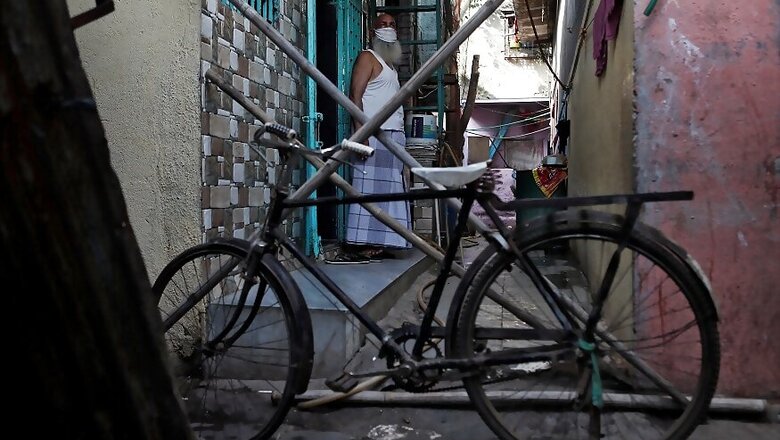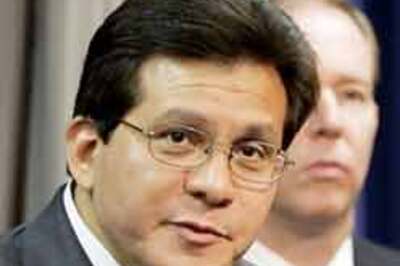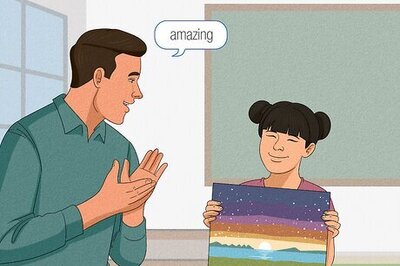
views
As India unlocks after more than two months, one fact is becoming increasingly clear: living with Covid-19 is our ‘new normal’ for the foreseeable future.
For a vast majority of India’s urban poor, who live in informal settlements like slums, this situation not only means a disproportionate level of exposure to the novel coronavirus because they do not have means of social distancing or the money to buy expensive protective gears, but also the daunting task of facing extreme poverty (in some cases even destitution) and large scale unemployment.
According to the 2011 census, almost one in six Indian city residents live in an urban slum. While the plight of the returning migrants during this pandemic have been extensively covered, the concerns and problems of these slum dwellers (many of whom were migrants themselves) have gone largely unnoticed.
To make things worse, the urban poor in the city of Kolkata found themselves doubly vulnerable during the lockdown as cyclone Amphan devastated their homes, and brought them to the street, where practicing social distancing wasn’t an option.
Mumbai slum dwellers, too, are now facing uncertain times as cyclone Nisarga gathers strength in the Arabian Sea, and threatens to cause heavy rainfall.
Many slums are based in the low-lying regions in Mumbai, and are likely to get affected if the cyclone were to impact Mumbai. Officers of wards closer to the western coast such as A, G/South, G/North, H/West, K/West, P/North, R/Central, R/South, have been instructed to evacuate people from informal coastal settlements to safer places. The slums in the interiors also stand at risk of being heavily affected with chances of trees falling, roof being blown over, homes being damaged or flooding.
This, however, is just the beginning. Monsoon is here and along with it are the usual problems that the urban poor have to put up with every year - the waterlogging, vector-borne diseases as well as floods, and they will have to brave it all with the added threat of a deadly virus this year.
A Cruel Irony
Dharavi, is perhaps one of the few slums in India that has received considerable attention from the government, BMC (Brihanmumbai Municipal Corporation) authorities, NGOs, media as well as public, during the pandemic.
With 71 Covid-19 related deaths so far and 1805 positive cases, it has become BMC's Achilles' heel.
In May alone, Dharavi, one of Asia's largest slums, reported 1,400 cases - a sharp spike of 380 per cent from its April figures. However, if Dharavikars are the worst affected, they are also proactively being tested.
"We are screening each and every person in Dharavi, and getting maximum people to quarantine centres for testing," said the Assistant Commissioner of ‘G/North’ Ward, Kiran S Dighavkar. The BMC has stationed many mobile dispensaries in Dharavi to screen residents, he added.
Dighavkar pointed out that doctors are distributing zinc and vitamin tablets to Dharavikars to boost their immunity and BMC is currently planning to build Covid care centres within the area with all the required equipment and facilities. A place with 200 oxygenated beds has already been set up in Dharavi.
"Our objective is to save the lives of the Dharavikars. We have to, unfortunately, accept the fact that in the absence of a vaccine, many will be infected. Corona is not leaving us in the near future. It will be with us in the years to come," said Dighavkar, adding, "Now the challenge will be not only to reduce the patients but increase the number of discharges."
Despite the efforts of BMC and the Maharashtra government to speed up rehabilitation process, the situation is far from better. New cases are being reported at a steady pace. But that isn't the worst part. Most of Dharavi's problems are structural - the lack of space for social distancing given its population density of over 270,000 people living per sq km, and poor sanitation infrastructure and water woes. These problems have existed for years and the arrival of Covid-19 have intensified them.
However, Dharavi, as is the cruel irony of this situation, is far more privileged than many other slums of India which are barely even being noticed. It is just a canary in a coal mine, indicative of many problems that urban poor are facing across India.
Invisible among the vulnerable: Curse of un-notified slums
In Kolkata, for instance, the registered slums which are under the jurisdiction of the corporation get all the attention, from the counselors and ward authorities. But the scenario is completely different for inhabitants of unregistered slums, points out Reshi Bhattacharya, ActionAid program manager, Women and Work Unit.
"Because these inhabitants are part of unregistered settlements, they are treated as homeless. During the Covid-19 induced lockdown, they also faced the devastation of Amphan cyclone and these sequences of events have made these people critically vulnerable," says Bhattacharya.
"These people need help too. Of course, the slums they live in are not as crowded as Dharavi, but still, we are talking about a lot of people. They are not encroachers, they are the people of our state who came from different districts to look for jobs. They are the informal workers, city builders, domestic helps. But, they are often labelled as encroachers and the general feeling is that they do not even have the right to be in the city, let alone the right to access support," she adds.
Bhattacharya's work mainly focuses on the young girls and women of these unregistered slum dwellers and she says that they neither have access to basic services, like food and health supplies nor are they being tested. Kolkata isn't the only city in India that has unregistered slums. In Mumbai and Delhi, many are residents of non-notified slums. Chennai is home to 1,979 such slums, Hyderabad has almost 200-300 of them and the list is long. There is a marked disparity between such settlements and notified slums. In all such settlements, life is far greater a struggle and the arrival of Covid-19 has only aggravated the difficulty of their residents.
Risk of 'living with Covid-19'
The inhabitants of both notified and un-notified slums are likely to pay a heavy price of living with the virus because the chances of them getting exposed to and contracting the disease are much greater, which is why testing is crucial especially now that the lockdown has been lifted in most parts.
"Even now, only symptomatic people are being screened, except for certain clusters, where everyone is being tested. However, that should not be the case. Especially, in areas that have dense informal settlements, where practicing social distancing is not a practical option," says Professor Partho Sarothi Ray, Associate Professor of biological sciences at the Indian Institute of Science Education and Research (IISER) Kolkata.
"Even asymptomatic people in such settings should be tested. Since slum dwellers are generally malnourished, the chances of them contracting the virus are higher, so is the possibility of deaths due to comorbidities. Therefore, in such clusters, active testing needs to be done," he adds.
The lockdown, and all the extended versions of it, were supposed to be implemented with two very clear objectives. The first objective was to test and isolate as many Covid-19 patients as possible. And, the second one was to prepare the healthcare system so that they can handle a large number of patients after the lockdown is lifted.
“Massive testing only started a couple of weeks before the lockdown ended, and even now it's not sufficient," he says. In the meantime, healthcare staff has been exposed to the virus and many were affected, which is likely to put a huge strain on an already overstretched healthcare system of the country.
“The government can try to ensure that there is enough infrastructure such as ICU or oxygenated beds, ventilators but that wouldn't mean anything if there are not enough staff members to treat COVID 19 patients, manage the infrastructure," points out Anant Bhan, a researcher of Bioethics and Health Policy at Global Health says unfortunately, India didn't accomplish either of these objectives.
"It is important to take care of healthcare workers who are treating COVID-19 patients, as well as ensure there is adequate staffing. In China, for instance, when cases mounted in Wuhan they brought in medical professionals from other cities but that might be a challenge for us in India. Too many states have been affected and it's going to be a challenge to get staffing reinforcement from other states. It will also not be tenable for the long term," he adds.
Bhan says it is not only important to keep the government doctors and nurses safe so that the public as well as healthcare professionals have faith in the system but also necessary to bring under the fold all the local doctors who were already working in slum areas.
"Also, just because Covid-19 is around, doesn't mean that other healthcare needs of patients like those who are fighting cancer, or need dialysis, have disappeared. So, it will be good to consider setting up health clinics in such clusters (slums) where they can not only identify individuals who might have been infected, or are at a higher risk of contracting the virus, and segregate such individuals, and also have mechanisms to offer treatment for non Covid-19 patients," he adds.
Although there has been talk of acquiring 'herd immunity' as a strategy to combat the virus, the doctor said that it is a questionable process because there is a lack of clarity on whether people will get enough immunity post-infection or they are susceptible to reinfection.
"More importantly, in the case of the vulnerable and the immunocompromised, like the elderly, those with pre-existing morbidity or those who are malnourished (causing weak immunity) there are chances of higher casualties if we do not protect them. So, the question arises as someone quipped, 'if you don't have enough herd left what will you do with the immunity’?" he adds.
However, Ray points out that at this point, more than the virus the urban poor are worried about their livelihoods.
“We are currently standing at a transitional point from a pandemic to large scale starvation. Unlike rural poor, who have their farms, and home gardens to carry them through this crisis (even if it is in a small way), the urban poor does not have such support. They are completely dependent on their jobs which most of them don't have right now.”
The economics of slum life
In the two months of lockdown, several slum inhabitants lost their employment and businesses. Dharavi itself is a hub of informal workers and sweatshop-like establishments where a wide range of things from leather to Jeans, to bags, are manufactured. However, the entire distribution chain has been disturbed now, and the ones who were at the bottom of this chain, and were workers for small-scale entrepreneurs, have been the worst affected.
"The margin between these small-scale entrepreneurs and their employees are razor-thin. If one manufacturing cycle gets disrupted, entrepreneurs tend to become workers, because they do not have the money to run their businesses anymore," points out Shweta Tambe, of Habitat and Livelihood Welfare Association which works in the slums of Bandra and Khar (Mumbai).
Therefore, Tambe explained that now that the lockdown is over there will be an additional set of entrepreneurs who are jobless. They were once the security net of their workers, but now that these workers need financial assistance desperately, but they are in no position to help them out.
"These employers are below MSME. It is one thing to have credit schemes for MSME but, what will happen to survivalist micro-enterprises which are too small to count as MSME?" asked Raghav Mehrotra from Aajeevika Bureau, a labour organisation that works in Gujarat, Maharashtra, and Rajasthan.
"Many of the workers who live in slums are not even waged. They are paid piece rates. So, for instance, they are paid by the number of shirts that they stitch or the number of pipes that they polish. They do a lot of home-based work too. Many women from this area are engaged in garment related works like dhaga cutting, or patchwork for small items that are sold on the street. The government should provide support to non-waged workers too. Most of the packages that have been announced are only for waged workers," he adds.
Unless the economy starts reviving, these communities will be gravely impacted, says Brinelle D'souza, faculty member at Centre for Health and Mental Health, TISS. "These are people who are at the frontline of the informal economy. We need to ensure that members of the unorganized sector are better organized and registered," she adds.
The crux of existence: Vertical slums are not a solution
Apart from that, another need of the hour is to carefully plan and redevelop slums. This crisis should lead us to something better. There has to be a consciousness that if some people are not safe, then society is not safe either.
"We need to relook at how we are designing houses for the urban poor. I hope we go into more affordable housing. Proper redevelopment of slum areas with adequate spacing, lighting, and ventilation are necessary. I hope we don't just take people from slums and keep them in the periphery of the city in project buildings," says D'Souza.
"Those buildings will eventually become vertical slums. Such buildings are mostly in the periphery of the cities which makes accessing healthcare, schools, market places very challenging," she adds.
The two basic problems for notified as well as non-notified slums are sanitation and water. "The Covid-19 advisories talk about washing hands for 20 seconds but how is it even a possible solution for those who cannot afford to buy water and are not even bathing regularly because of water crunch," says Sitaram Shelar, Centre for Promoting Democracy and Pani Haq Samiti.
He says that water and sanitation are the first things the government should look at, and build more toilets and clean the toilets more regularly if they intend to curb the number of rising cases.
“They need to overall improve the existing infrastructure of sanitation. Bring in mobile toilets in regions where there are no pre-existing toilets. Give financial assistance to the operators of the public toilets which will help them to provide free services. The authorities should provide public stand post water connection in all informal settlements and homeless communities so that they can access water supply," he adds.
Hygiene, however, is an afterthought when survival itself is a challenge, explains Shelar."Most of these people who have settled in cities are migrants who do not have voter ID or ration card so they cannot access several governmental schemes. They are extremely vulnerable, as they have already lost their jobs, exhausted savings, and many families are requesting money from villages to survive," he says.



















Comments
0 comment